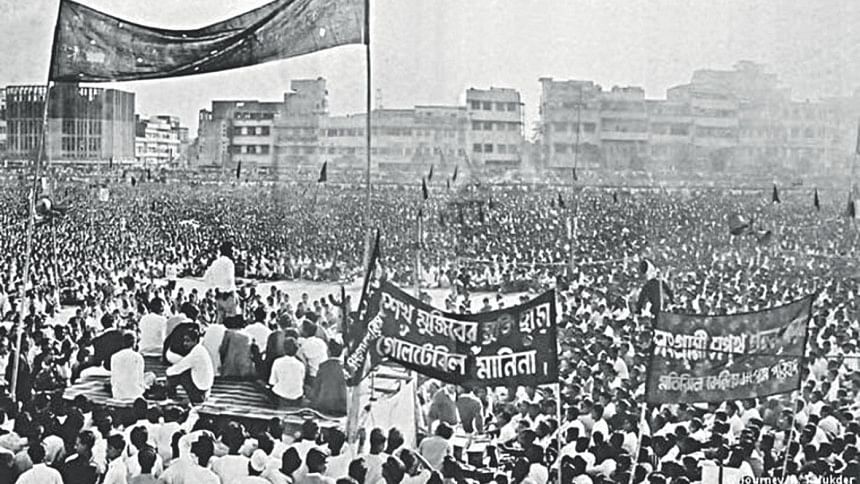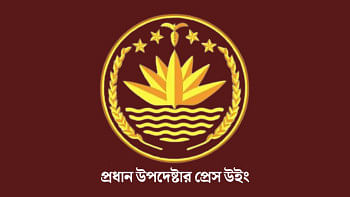Workers’ role in the 1969 Gherao Movement

In November 1968, the struggle against the dictatorial regime of Mohammad Ayub Khan began in the towns and cities of West Pakistan. At the beginning, the people of East Pakistan did not take the movement seriously except the Moscow NAP. The students—both the East Pakistan Students League and the East Pakistan Students Union protested on November 23 against police action in the west wing. It was followed by a public demonstration on November 24 by the Moscow NAP, starting from Baitul Mukarram in Dacca. From the end of November 1968 onwards, Maulana Bhashani, President of Peking NAP, called upon the rural poverty-stricken peasantry to ‘Gherao’ (surround) the houses of the corrupt development officers and Tahsil offices. In many districts such ‘Gherao’ started from December. The peasant revolt in Naxalbari, West Bengal in 1966 had an impact on the politically conscious peasant leaders of East Pakistan.
On December 6, Peking NAP announced that there would be a general strike in Dacca city on the following day in sympathy with the week-long strike by scooter-drivers. The strike was a success. The police opened fire at one or two places in the city. The government promulgated an order under Section 144 of the Code of Civil Procedure prohibiting all assemblies and processions for two months from December 7. The general strike called by Awami League on December 13 was supported by the progressive student organisations, Moscow NAP as well as other political parties such as PDM and the Peoples Party. It was a great success.
The conspiracy case against Sheikh Mujibur Rahman and others, generally known as the Agartala conspiracy case, instituted at the instance of the Pakistani regime and the reports published daily in the newspapers of the proceedings in the tribunal agitated the minds of the majority of the people of East Pakistan.
By the third week of January the students set up committees of action throughout the province and they were getting ready for any eventuality. The students’ agitation took a serious turn after Asad, a student leader, was killed by a bullet injury on the 20th January. The students declared hartal (general strike) on the 21st, mourning for three days.
The middle-class struggle for democratic rule under the bourgeoisie leadership was transformed into a revolutionary upsurge of the masses. The working population—the rickshaw pullers, motor drivers and all other day labourers—of the city joined hands with the students and defied law enforcers. The popular uprising shattered the facade of the regime’s stability and the administration collapsed. The shameless propaganda of the so-called “decade of progress” was going on in full swing through all available media—newspapers, meetings, pamphlets, booklets, radio and television—but collapsed like a house of cards.
The movement, initially started by Maulana Bhashani’s NAP group in the form of ‘Gherao’ of corrupt officers and government agencies, began to spread in the rural areas. In the first week of March, the proletariat section took it into their head to realise their demands from employers and the process started from the Tongi industrial area. ‘Gherao’ by the employees became a regular feature from the first week of March 1969. The employers were shaken.
Ayub Khan and especially his governor, Monem Khan, made a last-minute effort to remain in power. An Islamic Constitution Day was observed on March 23 when the Field Marshal’s Party joined hands with the village mullahs and some power-hungry Islamist fanatics brought out processions in the name of saving Islam from the hands of ‘godless Communists’. The history of Indonesia was almost going to be repeated but the action and operation by the Ayub-Monem coterie were too late. Ayub handed over power to the new martial law authority, Commander-in-Chief of the Armed Forces, and retired on March 25, 1969
The ‘Gherao’ movement was not unknown in East Pakistan. In 1954, there was a ‘Gherao’ in Kushtia Mohini Mills. In 1964, there was a ‘Gherao’ of the Peoples Jute Mills in Khulna which continued for 12 days. In April 1965, it happened in Amin Jute Mills in Chittagong. But the ‘Gheraos’ in March 1969 were not only by workers of the factories and offices but by the students’ committees of action and inspired by some political parties—both Moscow and Peking National Awami Parties and Awami League. The ‘Gherao’ movement of 1969 has to be understood and appreciated in the new perspective. The country witnessed scenes that were unprecedented in their character, in their impact, and in their abiding sociological import.

It was clear from the very beginning that the new martial law authority will be different from that of the martial law in 1958. The employers and industrialists who welcomed the promulgation were surprised and shocked when it was announced that the employers who had signed agreements in the month of March 1969 were to honour those agreements, though almost all of them were signed under ‘Gherao’. Most of the employers who had signed agreements in March decided to institute civil and criminal cases in the court of law for a declaration that the agreements entered into were under duress and therefore not enforceable.
On April 9, the heads of firms in East Pakistan received the following letter from the Director of Labour clarifying their position:
“It has been brought to the notice of the authorities that some employers are thinking of taking action against the workers for inciting and taking part in gherao/demonstrations etc., immediately before the imposition of the Martial Law. It was decided that the employers should be requested not to victimise the workers for their activities in connection with gherao/demonstrations etc. This, however, does not debar the employers from taking action against the workers for other acts of indiscipline or misconduct. In such cases, the employers may take appropriate action under due process of law. The trade unions and the labour organisations would continue to function and carry on their usual activities as per law subject to Martial Law orders whereby strikes/lock out/agitations etc. have been prohibited and meetings etc. cannot be held without the prior permission of the Martial Law authorities.”
Air Marshal Nur Khan, deputy chief martial law administrator met the trade union leaders of East Pakistan on April 10, 1969. The labour leaders emphasised the following points:
1. Anti-worker labour laws enacted in 1965 should be repealed.
2. Unusual delay in the settlement of disputes and disposal of cases by labour courts should be avoided.
3. Inadequacies and weaknesses of machineries set up by the government for implementation of labour laws should be removed.
Air Marshal Nur Khan recommended an outline of the Labour-Management Relations Policy after his meetings with labour leaders and employers. The broad principles envisaged were:
Freedom of association so that the workers may form trade unions of their own free choice and select their representatives by secret ballot.
Strengthening the scope of collective bargaining by conceding the right to strike.
To guarantee a fair and equitable living minimum wage.
Consolidation and simplification of labour laws, strictly in accordance with the ratified conventions of the ILO.
Review of the schedules of essential and public utility services and to reduce them to the barest minimum.
Effective implementation of labour laws for protecting the rights of workers, including the minimum wage.
Uniform application of labour laws without discrimination between public and private sectors.
Relating the wage structure to productivity by increasing the workers’ share in quality and guarantee of production.
The Air Marshal tried to impress upon the employers during the interviews that by and large, the workers had been deprived of their genuine rights so far and the government could not remain indifferent to such a state of affairs.
On May 7, the government announced its decision to bring uniformity among various labour laws in Pakistan. The central government convened a special All Pakistan Labour Conference at Karachi on May 15 to examine the entire gamut of labour problems both in public and private sectors in the light of the guidelines of the new Labour Policy of the government. The Labour Secretary referred to the recent labour unrest and asked all concerned to critique to find out why such an uprising took place suddenly. He told the employers that the government wanted the industry to prosper but at the same time, it wanted that social justice be done.
The report submitted by the chairman of the group on wages and welfare contained varying views on the fixation of minimum wages. The workers’ point of view was that the minimum wages should be fixed on the basis of consumption budget of a worker. Accordingly, the minimum wage in West Pakistan should be Rs 220 per month and Rs 260 in East Pakistan. The employers, however, argued that the capacity of the industry to pay should be the prime consideration. Both sides in this group were unanimous that there should be an independent Minimum Wage Commission to compile the cost of living indices and recommend annually the new levels of minimum wage to reflect change in the cost of living. With regard to the recommendations of three other committees, the differences were not so wide and it was therefore expected that the recommendations would by and large be accepted by the government.
On May 20, 1969 it was announced by the martial law authority that no retrenchment/termination of service of workers shall be done prior approval of the martial law authorities. The government of Pakistan announced its official policy in July 1969. On August 2, 1969 the government of East Pakistan promulgated The East Pakistan Minimum Wages (Fixation) Ordinance, 1969 to fix minimum rates of wages of unskilled workers employed in certain commercial and industrial establishments and tea gardens.
The ordinance shook the foundation of many establishments and the employers faced unrest all over the province among workers. Major industries such as jute and cotton textile, in spite of various difficulties in implementing the Labour Policy and the provisions of the Minimum Wages (Fixation) Ordinance, 1969, prepared new wage schedule to bring up the minimum wages of unskilled workers to the statutory limit and to give reasonable increase to the semi-skilled and skilled workers. These were not, however, acceptable to the workers and their unions. The union leaders contended that the employers violated the spirit of the government Labour Policy by not negotiating with the unions for fixing the new wage structures and therefore on principle they could not accept the employers’ offers. They also argued that the fixation of the pay scales was not done on the basis of the principles of fair return to workers. The unrest among the workers became visible. The Pakistan Jute Manufacturers Organisation, after protracted negotiations with the union leaders, entered into an agreement but as no agreement could be arrived at between cotton textiles mill owners and union leaders, the government referred the disputes to the Labour Court for adjudication but the strike in Tongi area in Dhaka continued until December 10 when a settlement was arrived at.
This is an excerpt (edited for clarity) from the book “Labour Movement in Bangladesh” by Kamruddin Ahmad. He was a prominent trade union activist and author of several important books on the social-political history of Bangladesh.

 For all latest news, follow The Daily Star's Google News channel.
For all latest news, follow The Daily Star's Google News channel. 



Comments